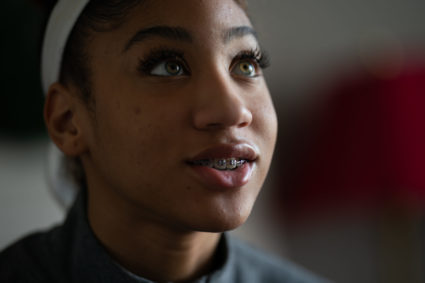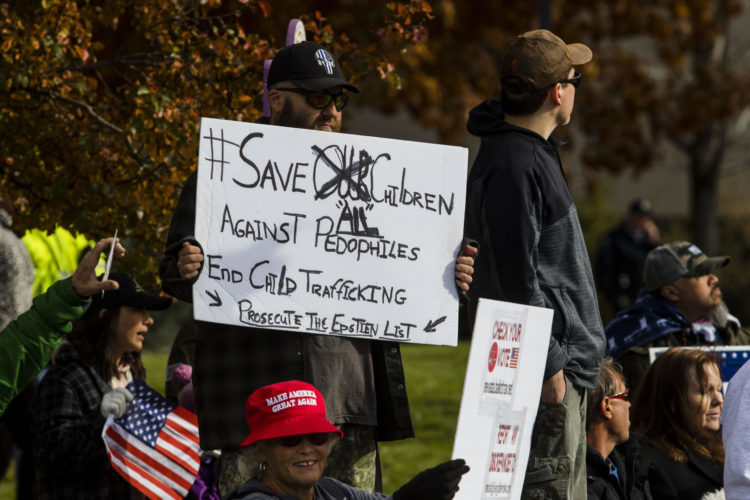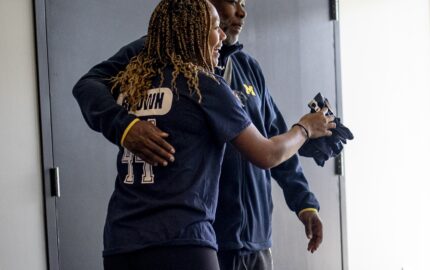These days, a conspiracy theory can burn through a population like a pathogen. And while these theories are built on top of untruths, the ripples they send out in the world can be very real.
Jessica Contrera of The Washington Post recently traced one such ripple: “QAnon con: How the viral Wayfair sex trafficking lie hurt real kids” published Dec. 16, 2021. It tarted with outlandish claims that Wayfair, an online home-goods and furniture company, was involved in human trafficking. As the claim multiplied and mutated, it swept up victims, including a teenager falsely tabbed as a victim, and sex-trafficking opponents who watched as attempts to help real victims were overtaken by hysteria over fake ones.
Contrera opens with the story of a teenager whose life was upended by false claims she was a victim of trafficking. From there, Contrera pulls in more and more people involved and affected. She describes a runaway train, giving readers a sobering sense of how fast and recklessly conspiracy theories can travel.

“If we had just told the story of a conspiracy theory’s harm to (the teenager), it simply wouldn’t be an accurate story,” Contrera told me. “Because the repercussions were so, so much bigger and are still unfolding today.”
To tell the story fully, Contrera needed many of the tools in her reporting-writing toolbox. From a previous story following the path of a single cheeseburger, she gleaned a structure that could let readers follow the conspiracy theory. Thanks to her previous work covering sex-trafficking, she was able to consider how to write about a sensitive issue without further harming those who had already been hurt.
She urges journalists to exercise patience, and consider a closer look at stories that may seem like they’ve already passed by.
“This reporting process was a reminder that just because a story has already been written about, or a lot of time has passed, it doesn’t mean it’s not worth doing,” she said. “Some of the richest reporting can come after the public has stopped paying attention.”
In an interview with Storyboard, Contrera explained how the Wayfair story came together. Her answers have been edited for clarity.
The bio at the end of the story says you write about people whose lives have been “transformed by major events and issues in the news.” How did your role at the Washington Post develop that focus?
I’ve always been most moved by stories that explain the big controversies of our time by finding the people who are experiencing them firsthand and letting readers walk in their shoes. I feel incredibly lucky to work at a news organization that values those kinds of stories, and to have an editor, Lynda Robinson, who understands the time, resources and care it takes to do them. Our team, called the local enterprise team, also hops in whenever there are major events in D.C., so a significant part of the job is witnessing or writing those first-draft-of-history moments.
How did the story on the Wayfair sex-trafficking conspiracy claims came about.
I’ve been writing about the way that child sex trafficking cases are mishandled and misunderstood in our country. The idea of child sex trafficking most people have — kidnapping, border crossings, physical chains — is almost never in line with reality, which is vulnerable kids groomed by someone they come to trust. That misunderstanding has been seized upon by individuals who want to scare people, especially women, for political gain. Again and again, I heard from advocates and survivors about how sensationalized stories, whether well-meaning or hyped by QAnon, cause harm. I wanted to figure out how to show the consequences of that harm on real children and real victims of trafficking.
Tell us a bit about the reporting and writing, and the main challenges you faced.
During the early days of the pandemic, I did stories that tracked individual objects through supply chains. I am not cut out to be a business reporter, but by following one item, like a cheeseburger, you got to meet all the people on the journey and learn about the unequal ways COVID was upending their lives. So for this story, I hoped to use the same method: Follow one conspiracy theory from start to finish and see who it impacts along the way. The Wayfair conspiracy theory was the most obvious choice because it had gone so viral, so fast, had a lasting footprint online, and most of all, had recklessly damaged the reputations of real kids.
The hardest part of the reporting was going from the vague to the specific. Not just explaining that the trafficking hotline was overloaded, but finding a real advocate who couldn’t get timely help for a real victim. Not just talking about kids being harmed, but taking you into the panic attacks of one specific girl. That said, how do we do this reporting without causing additional harm? That’s the question I’m always asking myself. So we had to make tough decisions about what to include and what to leave out. We didn’t want to further amplify misinformation. And we didn’t want to draw attention to any kid who hadn’t explicitly said it was OK to do so.

One fascinating aspect about this story is its wide net. It opens and closes with Samara Duplessis, a 13-year-old from the Detroit-area who ran away from home in a moment of teen angst, then had her life upended by a series of viral lies. You could have had a fascinating-enough story if you’d focused only on her. Instead the lens widens to find more and more people who’ve been dragged in. At what point did you decide to take such a sweeping view, and why is such a story more beneficial for readers?
If we had just told the story of conspiracy theory’s harm to Samara, it simply wouldn’t be an accurate story. Because the repercussions were so, so much bigger and are still unfolding today. I’d known since reporting at the Capitol on Jan.6 and seeing all the “Save the Children” signs, that we needed to write about the way that false narratives about sex-trafficking are on-ramps to far-right extremism. For Rosanne Boyland, and likely many others, the Wayfair conspiracy theory was the first step onto that ramp.
Though keeping the story’s scope wide certainly made it more of a time investment for readers, my feeling was that if we were going to do a story about the harm caused, we needed to show as much of that harm as we could pin down.
I’m fond of a small touch in the lede, when you initially describe Samara as “the real Samara Duplessis.” Here it is in two sentences that both summarize and foreshadow:
The real Samara Duplessis was sprawled across her comforter, her thumb on Instagram. Summer could drag on in the Detroit suburbs, and the summer of 2020 — her eighth-grade graduation reduced to Zoom, her whole world masked and anxious — was already the most boring of them all.
Do you remember how you landed on that description?
Thank you! I wanted to establish very quickly that this was going to be a story about what was real, and what wasn’t. At that moment, there were two Samaras. The one the Internet was making up stories about, and the real one.
You profile Zari McFadden, whose tweet helped the conspiracy theory grow. How did you find out her role, and what was the process of approaching and interviewing her like?
Zari’s Wayfair tweet was among those that had the most traction, which I knew thanks to Marc-André Argentino, a researcher who had captured the Twitter ripple effect in real time. I found Zari’s academic resume online and emailed her, explaining why I wanted to talk with her. I interviewed a lot of people who had shared the Wayfair conspiracy theory who never made it into the story. They had varying ranges of remorse and understanding, but so much of Zari’s story was representative of the themes I kept hearing. She wanted to help. She thought it was a good thing to share just in case it was true. Once she realized she was wrong, she felt uncomfortable and uncertain of what to do next. Listening to her, I was reminded of all the times I’ve had the urge to post something without looking into it first. Her experience had served as a cautionary tale in her own life, and I thought it would do the same for readers.
I was agog at how thoroughly the Wayfair theory disrupted services for real sex-trafficking victims. There are several sources who address that, but the most vivid is Katie Howard, an advocate for victims. How did Katie get on your radar as a potential resource?
Thanks for asking about this. I spent time on Reddit forums for individuals whose family members had been radicalized by QAnon, reading in real time how the Wayfair conspiracy theory was taking hold. It included a copy of a Facebook post from an advocate venting about how the Human Trafficking Hotline had told her its slow response was due to the backup from the Wayfair lie. Even though Katie’s post was no longer public, I could use the URL to figure out which profile it came from, and I messaged her directly. There were a lot of moments like that, just sending emails, texts, voicemails and snail mail — then hoping. I never heard back from at least half of them. But you go into a story like this expecting that. I was incredibly grateful Katie responded and shared all she did. It allowed me to focus on the harm to a real trafficking victim without having to name her or potentially put her in more danger.
I like the way you thread Samara and her family throughout, which helps anchor an otherwise wide-reaching story: QAnon and other conspiracy groups; the metastasizing power of disinformation campaigns; the consequences for victims who had been trafficked. This summary was about Amazing Polly, one of the people who fed the internet storm:
Her June Wayfair tweet planted a seed that was cultivated by other social media users. By mid-July, they had matched the cabinet and pillow names to real children, dreamed up bogus meanings for SKU numbers and invented rumors about Wayfair executives. On Instagram and TikTok, self-proclaimed influencers who regularly posted about beauty products or motherhood gained hundreds of likes, followers and subscribers by repeating the lies.
Was that always the structure you had in mind, or did it change during writing or editing?
One of the many wonderful things about my editor is that she thinks about structure from the very beginning, and those conversations inform the reporting itself. I knew that focusing on a real child as the through-line would be the most compelling way to tell the story. What I didn’t know was whether the photographer, Sarah Voisin, and I would get that access. I started reaching out to families at the end of September. I didn’t spend time with Samara until early November, because it took time for her parents to feel comfortable with the idea. Without their participation, and Samara’s willingness to share what she’d been through, it would have been a much different story. I wasn’t going to focus on a child unless I felt certain that both the parents and the felt ready to let the world inside what was one of the hardest moments of their lives.
You draw from an impressive range of resources, everything from a TikTok creator to a University of Maryland study. How did you go about finding them?
One benefit of this story is how much of it played out on searchable social media platforms. I was coming off a story about the jailing of child trafficking victims in Las Vegas, where the harm being done to kids is usually only witnessed by a tight-knit group of police officers, judges and advocates. So I found it to be an incredible relief that there was so much evidence of the consequences of the Wayfair lie and other QAnon nonsense online. The harder part was figuring out how to link it together and when to stop reporting; we could have kept digging for months. (For what it’s worth to those looking for specific tools, I use Trello to organize everything I have and still need.) I’m also incredibly grateful to the survivors and advocates in the anti-trafficking community, who rightfully worry that bringing attention to the power of these conspiracy theories will only lead to more conspiracy theories. Without their trust and input, this story would have missed the point.
After a wider focus throughout the story, you return to Samara and close with the striking image of her looking in a mirror:
For the next few moments, at least, her image was hers to control.
How did you choose that as the story’s ending?
I’m always looking for that moment that feels like it tells a reader that long after you close this tab, this person is still going to be in the thick of this, and here’s what that future might look and feel like. With Samara, it felt like she was taking back some power. She’d been through hell, and she was aware that some consequences she’d never escape, but there she was, out in the world and trying new things. That felt like the most honest way to end: Don’t come at her. She’s not having it.
Is there anything you learned while doing this story that will help you while working on future stories, or may help other journalists?
I was reminded to be patient. When people have been through so much, and I reach out to them wanting to talk, it might take a few tries. They deserve the time to think about it, and to really understand what I’m asking of them.
This reporting process was also a good reminder that just because a story has already been written about, or a lot of time has passed, doesn’t mean it’s not worth doing. Some of the richest reporting can come after the public has stopped paying attention.
The whole year of reporting on this dark subject was a never-ending lesson in how to keep laughing and keep leaning on my people. Just before this story published, I was fact-checking like crazy, not sleeping enough, and getting threatening emails from a QAnon propagandist. Every day that week, our Federal Reserve reporter, Rachel Siegel, sent me a voice memo filled with truly terrible jokes: “Why couldn’t the man lift three tons of pasta?” “Because he wasn’t stroganoff.” Awful. And yet everything.
What are you currently reading for inspiration?
Amateur DIY blogs and roller skating TikTok, mostly. But I’m working my way through Bessel van derk Kolk’s “The Body Keeps the Score: Brain, Mind, and Body in the Healing of Trauma,” and revisiting “Trauma Stewardship” from Laura van Dernoot Lipsky and Connie Burk. So many of the people I write about have been through or are going through traumatic experiences. These books help me understand how that trauma impacts their actual brain chemistry and function, shaping so much about the way they see, show up in and react to the world.
They’re also helping me understand my own brain. Reporters are so often witnesses to and repositories for other people’s pain. I went into this career thinking that if I loved it enough, it wouldn’t affect me or my mental health. I quickly learned that wasn’t the case. I understand one option is to become numb to other’s suffering. But for me, not soaking it up means I can’t squeeze it out onto the page, or make a reader really know what it’s like for someone else. I could also minimize and repress the way this work impacts me, because the effects that I feel are so much less than what the people in my stories are going through. But not facing my own sh*t head-on means not doing what I need to do in order to be present for the next person, the next story.
Rather than pretend I’m not sometimes emotionally wrecked by what I see and hear, or just grinding through until I quit and become a dog walker, I’m trying to figure out how we both let our work affect us and make it sustainable. I’m inspired by the people who have done that in other fields, and I hope we as journalists can figure it out, too.
***
Trevor Pyle was a newspaper reporter in the Pacific Northwest for several years, and now is a communications officer for a regional nonprofit.
Subscribe to Our Newsletter
Get insights into the craft of journalism and storytelling in your inbox, delivered on Fridays.



